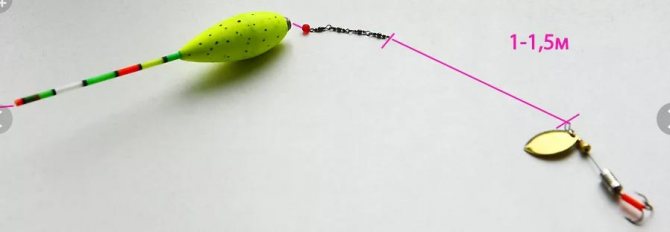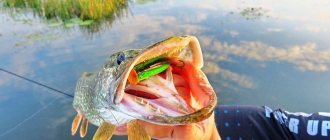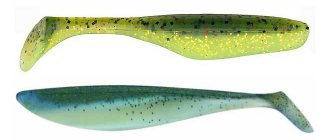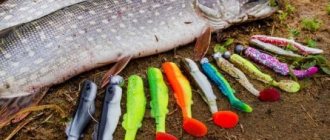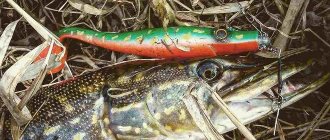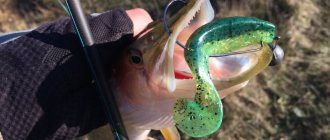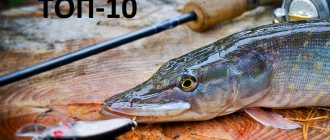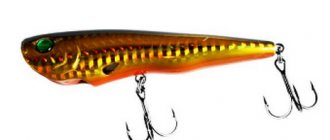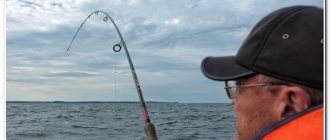Pike is a well-known predator, catching which is considered a great achievement among fishermen, and catching pike with a spinning rod is of interest to many fans of hunting for the toothy predator. To catch pike, you need to have fairly powerful and reliable gear, as it grows to impressive sizes, and even carp can envy its strength.
But for successful fishing, it is not enough to choose a good spinning rod for pike fishing; you still need to use it correctly. Catching large pike with a spinning rod is an art that contains many subtleties and secrets. Let's take a closer look at all this.
Choosing a fishing spot
One of the most important requirements for successful fishing is the right location. After all, catching pike with a spinning rod is a bit like hunting an animal - the predator must first be found and then forced to attack the bait.

Pike preferably hunt from ambush, so it would be logical to look for it in places where it can hide and wait for prey to swim nearby. A predator's lightning attack is often fatal to the victim.
Usually you should look for pike:
- in driftwood;
- fallen trees;
- thickets of reeds or reeds.
Often the results are achieved by casting bait to the border of clear water and plants or thickets; the bait must be cast along this border. Usually the predator waits for prey in such places. But not everything is so good - the probability of getting hooked and being left without bait is very high.
Also, a signal for the fisherman can be the predator hitting the water during an attack in shallow water. If you notice the blows of a pike in shallow water or a fry that jumps sharply in different directions, you know that a pike is hunting there.
Spoons for pike
Choice of spinners
Spoons are one of the most popular lures designed for pike fishing, but choosing the right one can be extremely difficult. For this reason, it is often necessary to have a whole set of different models in order to try them one by one in practice and understand what kind of food a predator prefers in a particular body of water at a given time.
The only exceptions are situations when the pike, for some reason, does not have enough food, then its behavior begins to be characterized by an increased level of aggressiveness, and it begins to grab any bait, as well as attack its competitors.
In other cases, one of the main criteria for choosing a spinner is weather conditions and light levels:
- During clear and sufficiently sunny weather, it is recommended to use white or as light as possible spinners. They will emit glare, which will additionally attract the attention of the predator.
- If the weather is stable and cloudy , then spinners with a yellow color usually show the greatest effectiveness.
- In weather that is changeable and partly cloudy , it is best to use two-color bait options.
You can also give additional tips that can help in the process of choosing a bait of this type:
- The most catchy ones are considered to be spinners belonging to the class of rotating spoons. The optimal size of such bait is No. 3-6, the choice is made depending on the expected mass of the prey.
- The shape of the petals with which rotating spoons are equipped plays an important role. It is recommended to choose models equipped with the following type of petals: Long, which looks like a small willow leaf; Comet, which is the most versatile option, and Aglia, which has a recognizable round shape.
- The presence of a tee edge on the spoon increases its effectiveness , since this element allows you to hold the bait in a horizontal plane, attracts the attention of the pike, increases the weight of the bait and can be treated with flavors that will retain the corresponding smell for a long time due to the characteristics of the material.
- When choosing an oscillating spoon, which with its play and appearance depicts a fish, you must first of all pay attention to its dimensions. This variety will not create significant vibrations when casting, and, therefore, should attract a predator with its size.
The best spinners
To make it easier to navigate the wide range of modern spinners, below are examples of models that show good performance when fishing for pike:
Blue Fox Super Vibrax is an acoustic-type spinner and, due to its catchability, is always popular with most fishermen. The body of the bait is designed in a special way, so it has an additional effect that prevents it from twisting. When wiring, additional vibrations will be created that will attract the attention of the predator. Depending on the size and color, the price ranges from 150 to 220 rubles.
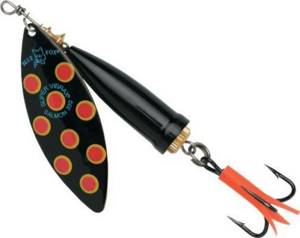
Mepps Aglia Long is a classic type spinner, made in the shape of a willow leaf. Many people use it when fishing in places with rapid currents, since even in such conditions the spoon retains its natural action. Lures of sizes suitable for pike fishing cost from 200 to 450 rubles.
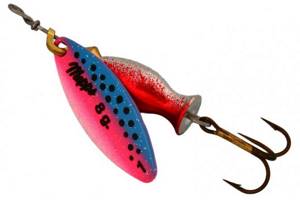
Mepps Syclops is a spinner, the main secret of which is the presence of ten facets of light reflection. The game is natural and persists at any speed, which makes this bait not only effective, but also a universal option. The approximate cost is 950-1000 rubles.

Tackle
It is quite difficult to choose gear for catching pike with a spinning rod, despite all the simplicity that may come to the mind of novice fishermen. Pike is a fairly strong predator and, therefore, the tackle must be powerful and reliable so that it does not let you down at the most crucial moment.
This predator grows to very large sizes; there are even known facts when the largest pike was caught using a spinning rod. Therefore, you should always protect yourself and choose durable gear so that pike fishing with a spinning rod is successful.
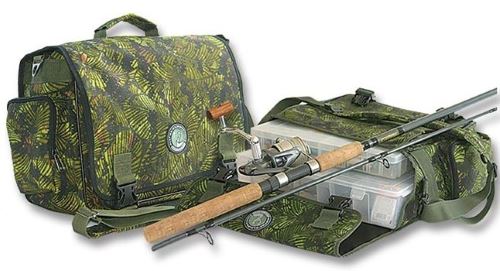
Spinning
The question of which spinning rod to choose for pike fishing is asked by anglers immediately after they decide on the fishing conditions. If you plan to catch pike from the shore using a spinning rod, then a 2.8-meter rod will be enough for you, which will not create discomfort while fishing. Well, catching pike from a boat using a spinning rod requires the fisherman to have a spinning rod of shorter length, about 2 meters.
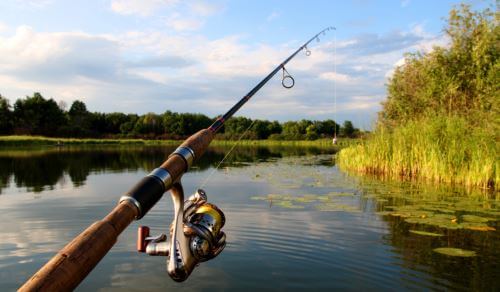
The choice of rod power is directly influenced by the size of the bait used and the size of the expected prey. If you catch pike with a spinning rod using a microjig, then you will only need to choose a spinning rod with a test weight of up to 10 grams. When fishing with wobblers and spinners, it is better to take sticks with an average test range from 5 to 20 grams. And for fishing on a river with a large current, you need to buy a more powerful spinning rod, with a test weight of about 40 grams.
For fishing with wobblers, spinning rods of medium or fast action are selected. And for using spinners and small silicone baits, a slow action blank will be sufficient; in some conditions (for fishing on small rivers) it is better to use a fast action spinning rod.
Coil
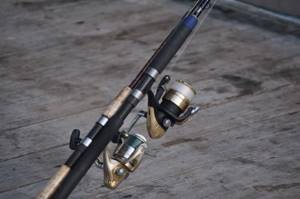
You need to choose a reel very carefully, it is worth noting one important piece of advice right away - take reels only from well-known manufacturers that you have used yourself and are confident in their quality
. It is better to choose a reel spool size of about 1500-2500 according to the Shimano classification. This size is enough to wind 100 meters of fishing line or braid with a diameter of about 0.25 mm.
Otherwise, the requirements for the coil are standard:
- smooth ride;
- at least three bearings;
- friction brake with the ability to be sensitively adjusted.
fishing line
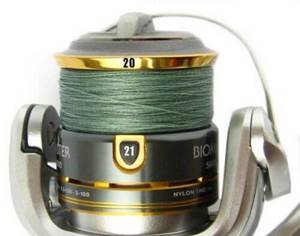
Questions about what is better than fishing line or braid have been circulating among fishermen for several years now, but there is still no clear answer to this question. It’s simple – a certain type of fishing line is better suited for certain conditions. For example, for jig fishing it is better to use braided line. And for fishing in other ways, a high-quality and reliable fishing line will be enough.
Leash
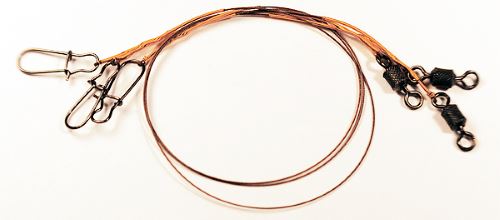
Fishing for pike with a spinning rod requires the use of a metal leash.
. The teeth of this predator are very sharp and large, so the likelihood that the fish will bite the fishing line is quite high.
Fishermen most often use the following leashes:
- Tungsten;
- Metal (steel);
- Kevlar.
Some people prefer to make their own leashes, for example from guitar strings. It’s quite simple to make: take a piece of string and make two loops at its ends. The main line must be attached to one loop, and the bait is attached to the other. To change baits as quickly as possible while fishing, you can attach a clasp to one loop. Such leashes are often used when fishing for pike with live bait.
Equipment
The equipment is quite varied, but there is talk among spinners that only one is catchy. It is used quite often and almost every angler is familiar with it. The idea is extremely simple - a metal leash with a clasp is attached to the end of the main line, and then the bait is attached to it. Very often, fishermen are afraid that a leash will scare away a predator and refuse to use it. It is not right.
Lures for pike fishing with spinning rods | Rating of the best, video
Pike is one of the most attractive hunting objects for beginners and experienced spinning anglers. It is of great interest, since this fish is found even in small rivers, reservoirs and lakes. Fishing for pike with a spinning rod has many features and nuances, without which fishing may not take place.
Choosing a Rod and Reel
A large pike is a strong and serious predator, so let's look at the gear for pike fishing.
When choosing a good spinning rod for pike, there is no need to purchase expensive models made using Japanese or American technology, because Korean and Chinese spinning rods from some manufacturers are also quite high quality.
Let's figure out what kind of spinning rod we need for pike. For pike fishing, a spinning rod with a fast action (easily bending tip) is best suited.
Pike is one of the most attractive hunting objects for beginners and experienced spinning anglers. It is of great interest, since this fish is found even in small rivers, reservoirs and lakes. Fishing for pike with a spinning rod has many features and nuances, without which fishing may not take place.
Choosing a Rod and Reel
A large pike is a strong and serious predator, so let's look at the gear for pike fishing.
When choosing a good spinning rod for pike, there is no need to purchase expensive models made using Japanese or American technology, because Korean and Chinese spinning rods from some manufacturers are also quite high quality.
Let's figure out what kind of spinning rod we need for pike. For pike fishing, a spinning rod with a fast action (easily bending tip) is best suited.
As for the length of the rod, it depends on where the fishing will be done from - from the shore or from a boat. If you plan to fish on the shore, then the best length is considered to be 2.7 meters, and for fishing from a boat, 2.1 meters will be enough.
In order to catch pike using spinners, wobblers and other soft baits, almost all spinning rods are suitable.
If an angler prefers jig fishing, ultralight, or twitching a wobbler, then in these options it is preferable for the rod to be reliable and expensive.
The best spinning rods for pike fishing
To catch large specimens, you should consider this pair of rods:
- Shimano BeastMaster
- Black Hole Bassmania
They are characterized by high strength. Black Hole Bassmania is a pretty fast spinning rod. These spinning rods can be used to fish both in the current and in a calm pond.
You can pay attention to the Banax Ultra line of fishing rods, as well as Black Hole classic Elite - simpler models
Assembling a rod with a reel
Some anglers prefer telescopic spinning rod models. They are practical, convenient and compact for storage and transportation; they fold and unfold very easily.
Many professional spinning anglers prefer to assemble the rod themselves. At the same time, they can take into account their characteristics, individual preferences and requirements.
To make a spinning rod yourself, you need to order accessories, a handle and a form.
The main thing in the reel is the friction brake. There should be no excesses in it. It should have a smooth ride; about 50-70 meters of 0.25 fishing line will be wound around it. The ideal spool size is 1500-2500.
Correct fishing line and leash
Beginners often use monofilament when fishing with a spinning rod, but every experienced angler knows a good alternative. Braid is indispensable when fishing for pike with a spinning rod. It hardly stretches, which allows you to determine the place where the bait is located, as well as extremely quickly and clearly identify any bite, even a minor one.
A leash for a spinning rod is necessary so that predatory fish do not damage the fishing line by biting it. There are three types of leashes:
- tungsten;
- steel;
- Kevlar.
You can also make a leash yourself from an ordinary guitar string.
What is the best way to catch pike?
When catching fish, it is very important what you use to catch it. There are several main types of bait:
Jig (silicone baits, foam fish)
Jigs have a “head” and a “tail” shape. A massive sinker with a hook is the “head”. The “tail” is made from silicone rubber, foam rubber, as well as from animal hair and bird feathers. This is one of the ancient baits, perhaps the best for catching pike.
Because the jig head is heavy, it sinks quickly and can be easily handled by even novice anglers. Its hook is directed upward with the sting, which helps to avoid unnecessary hooks.
For many fishermen, the indisputable advantage of jig is that it is possible to assemble catchy tackle quite inexpensively. The head is made of different materials, mainly lead. Recently, jigs in the form of silicone and foam fish and plastic worms have become very popular. In addition, they can be made from nylon or synthetics. They have different sizes and weights.
Wobblers (surface and deep-water)
This type of bait has one or two hooks. It is an imitation of a fish made of wood or plastic. The main parameters for classifying wobblers are:
- in the buoyancy of the bait;
- in the shape of the body;
- presence or absence of a blade;
- at the depth of the dive.
Wobblers are divided according to buoyancy:
- for sinking ones (they tend to go deeper when retrieving);
- floating (remain on the surface of the water);
- suspenders (the bait hangs in the water).
Wobblers can be deep-sea (they are used for trolling fishing) and surface (they are good for catching pike in the summer).
The blade of the wobbler plays a very important role. Their body shape varies:
- Shad (Shad) - Wobbler resembling a herring.
- Fat is a fish shaped more like a sphere or a drop.
- Crank is a flat, coin-shaped bait that resembles the shape of a whitebait.
- Minnow (Minnow) is an imitation of a thin fish like a gudgeon or bleak.
Basically, the differences between different wobblers in terms of buoyancy come down to the structure of the front blade, its shape, size and angle of location relative to the fishing line.
There are also different types of wobblers without a blade
- darter;
- jerkbait;
- Rattlin.
For surface fishing the following models are used:
- popper;
- Walker;
- chagger;
- crawler.
For surface fishing, the most popular type of wobbler is the popper . This bait is distinguished by the fact that it imitates the sounds of gurgling, luring a predator.
A bait such as a walker is similar to the movements of a dog on a leash and is not particularly liked by pike .
Jerkbaits imitate loud noise and create waves, which also attracts predatory fish. In deep-sea fishing, sinking wobblers are usually used. Such models submerge deeply in water and produce noise effects. This bait will not leave a large pike indifferent, and further actions will depend on the angler’s reaction.
Non-snappy hooks for fishing in the grass
Catching pike with a non-hooking hook has many advantages. Pike can often be found in thickets of grass, and not in open water, so the ability not to hook the bait is a very important aspect in the success of pike fishing. Firstly, grass is a favorite place for predators. Especially often it is possible to catch large fish in it, since they hide in thickets of grass or in deep holes.
Secondly, fishing in the grass is equally fruitful at any time of the day, since the active behavior of pike in such places almost never ends.
Source: https://hariuz.ru/fish/pike/primanki-dlya-lovli-shhuki-na-spinning.html
Lures
Despite the widespread use of wobblers and a large number of silicone baits of various kinds, catching pike on a spinning rod using rotating and oscillating spoons still has its fans.
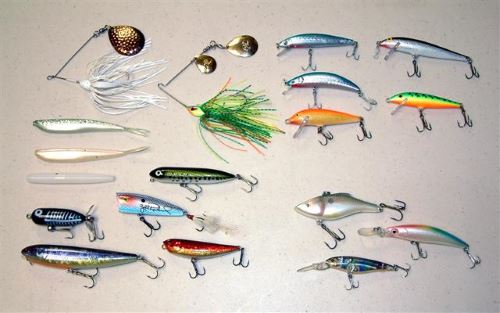
The low-frequency play of spinners can provoke a predator to attack, but the whole difficulty is that the bait must be positioned correctly. With the right approach, a spoon can completely replace wobblers and other baits, especially since it costs tens of times less. And many fishermen make such baits themselves, which greatly simplifies preparation for fishing.
But, unfortunately, spinners cannot always fully replace wobblers. Firstly, it is quite difficult to fish with them in some conditions, so the use of wobblers will be justified. Secondly, the activity of pike is seasonal and sometimes it can be quite difficult to tempt it with something else.
Wobblers
Often these baits differ due to several factors, but the main one is still buoyancy. Based on buoyancy, the following types of wobblers can be distinguished:
- Floating;
- Neutral buoyancy (suspenders);
- Drowning.
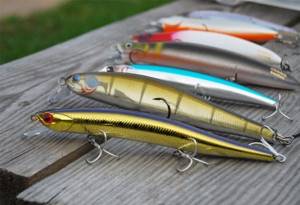
Wobblers with positive and neutral buoyancy are used much more often than sinking ones. The advantage of such baits is the possibility of fishing in large areas of the reservoir, in which there are snags and thickets of aquatic vegetation.
Minnow wobblers have gained great popularity among fishermen who love to hunt for pike. This name indicates the elongated and narrow shape of the bait, and the length can be very varied. We have already talked about such baits in the article: the best wobblers for pike 2021 according to fishermen.
Typically, fishermen use baits about 7 centimeters long; less often (especially in autumn) wobblers up to 14 centimeters in length are used.
Silicone baits

Among the wide variety of silicone baits for pike fishing, twisters or vibrotails are most often used. Various types of silicone worms are not widely used among pike fishing enthusiasts, but catching pike perch on a jig with these baits is quite successful.
Often, pike are caught with such baits in early spring or autumn, when the water has not yet warmed up enough and the predator stays at depth. Fishermen use baits made from regular or edible silicone. Mainly used for jig fishing.
Oscillating spoons
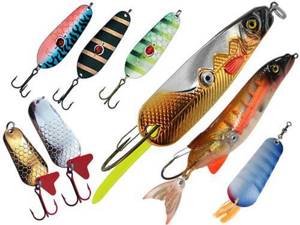
The favorite lures of many spinning anglers (mine included), which have been tested in our own experience and continue to catch pike for years. They are very catchy and provoke fish to attack with great success.
Surely all this is because they meet the basic requirements for baits of this kind:
- Allows you to fish at great depths.
- Available in small to large sizes.
- They have low-frequency play.
Spinners
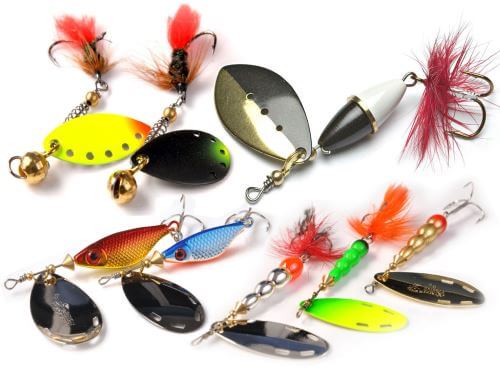
When the pike is very active, there is simply no substitute for spinners - they perfectly provoke an active predator to attack. But a significant drawback sharply narrows the scope of application of such baits; everyone knows that they can only be carried out with uniform and continuous wiring
.
Spinnerbaits
Quite an interesting, but at the same time too complex bait. The above lures for catching pike with a spinning rod are very simple, which cannot be said about spinnerbaits. They are used when the predator flatly refuses other baits (that is, when the pike is very lethargic).
Selection of baits in spring, summer and autumn
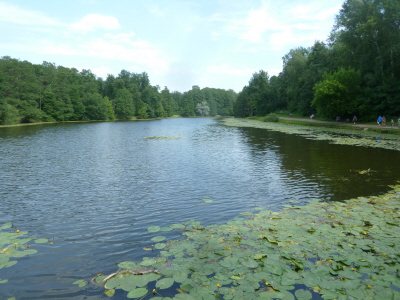
For catching pike in the spring, light, small spinners, spoons, and wobblers are ideal. These lures produce fairly strong vibrations that help attract fish in muddy spring waters.
In summer, pike are more willing to use spinning hooks than in spring, and the range of catchable baits increases. Both wobblers, poppers, walkers, light spinners, as well as spinners, twisters and spinnerbaits can be profitable. This is a matter of individual choice and preference.
Autumn fishing is a good period for jig fishing and deep lures. September – October – the maximum level of bite in the season. Pike is not as careful as during all other months. In the spring, it usually moves to a depth, namely to the border of the hole at a depth of 4-8 m. If you find yourself in a bad bite, then you should choose a bait of the natural color of a fry or fish that the pike feeds on in a particular reservoir, then the chance of catching fish will increase.
Methods of fishing and posting
Over the course of its existence, pike fishing with a spinning rod has changed and taken all possible directions. Among fishermen, only two methods of catching predators using a spinning rod are known and popular:
- trolling;
- casting.
The latter, in turn, is divided into three entertaining and common methods:
- glitter;
- jig;
- twitching.
Trolling
The technique of fishing for pike by trolling is quite simple; any novice fisherman can master it. It consists of the following actions:
- First you need to go by boat to the selected area of the reservoir.
- Now you need to throw the bait in the opposite direction of the boat's movement.
- Then you need to start moving the boat.
- Release some line from the reel and close the clamp.
- While the boat is moving, the bait is constantly in motion.
- As soon as you notice a bite, hook and get the fish.
Often, for trolling, wobblers are chosen as bait, much less often they are caught using oscillating spinners of impressive size.
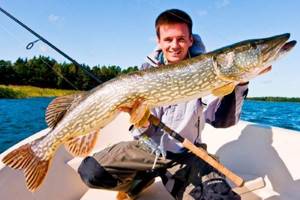
This is a very interesting way of fishing, which allows fishermen to easily accomplish two main tasks of a spinning rod:
- determine the location of the fish;
- catch a big pike.
It is best to go trolling fishing from mid-summer (when the spawning ban has already ended) until the end of autumn. Very often, after catching fish, the boat is anchored and the place is fished using the usual method for everyone, using a spoon or wobbler.
Spoon fishing
Fishing for pike using spinning rods and lures begins in mid-summer and continues until late autumn, when the reservoirs begin to be covered with ice. The technique for placing oscillating and rotating spinners is identical. But the wiring of the turntable should be more stable (meaning fewer pauses and sharp jerks).
There are 4 main types of spinner fishing when fishing with a spinning rod:
- Winding the fishing line onto the reel at a constant speed - uniform wiring
. - Winding fishing line onto a reel with an interruption of 3-4 seconds - stepped wiring
. - Following the pause, there is a sharp jerk with the tip of the spinning rod - a jerk retrieve.
- Giving the tip of the rod additional play during a stepped or uniform retrieve - twitching
.
Twitching
Twitching is the name given to catching pike with a spinning rod using lures, often wobblers, which do not have their own game. Artificial lures create very beautiful movements when twitching the tip of the rod, which makes the pike bite on them.
Jig
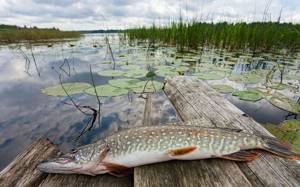
Surely, many anglers have heard about jig fishing for pike. This is a fairly common fishing method that uses silicone baits. Silicone baits are attached to jig heads or eared sinkers.
But jig fishing includes several different types, which differ in the type of installation and wiring of the bait:
- Classic stepped wiring
. Installation of the bait, rigidly attached with a sinker, to the end of the main fishing line. - Drop shot rig
. A weight is mounted at the end of the main line, and the bait itself is located a little higher; it is tied without a leash. An excellent feature of this equipment is the ability to actively play with the bait in one place. - Installation on a branch lead
(Moscow equipment). Spaced gear, which is known among many fishermen, features the separation of cargo and bait. A sinker is fixed at the end of the fishing line, and a leash is tied just above it (20-50 centimeters), and the equipment is already mounted to it. - Texas rig
. A sliding sinker in the shape of an olive or bullet moves freely along the main line, and the bait is tied to the end of it. - Carolina rig
. It has some similarities with the previous one, but the sinker is on a spaced leash, and not on the main line.
A feature of the last three equipment is the possibility of fishing in hard-to-reach areas of the reservoir, in which, for example, catching pike in the summer with a spinning rod from the shore using wobblers or spoons would be impossible or quite difficult. This gives them an advantage over other gear.
Pike bait and spinning fishing
One of the most common types of fishing on the entire planet is fishing with a spinning rod. This fishing method is acceptable not only on small rivers and lakes, but even on seas and oceans. Spinning is not only a certain fishing tackle, but also the method of fishing with a rod and reel.
The British are considered to be the founders of the spinning fishing process. It is known that since the middle of the 19th century, spinning bait was cast without the help of a reel.
At that time, their design was very imperfect and, at high ejection speeds, the fishing line often got tangled. Therefore, it was removed, arranged in rings on the ground, and the casting process itself was performed manually.
But the bait was wired using a reel.
In 1880, the journal Nature and Hunting published an article that described a method of fishing using a spinning rod. Since this time, the origin of this type of fishing in Russia is considered.
There are three main methods of fishing using spinning rods:
- Fishing from the shore . This fishing method is considered the most common. This method gained its recognition mainly due to its easy accessibility for every person, because not many people have the opportunity to have a means of transportation on water, and in many reservoirs fishing from a boat is prohibited. Casting is much easier to do while standing on the shore from a convenient place. Although practically fishing is more productive in hard-to-reach places. Having made several casts of bait with a spinning rod and not detecting the presence of a pike in a given place, the fisherman easily moves to another place and continues the search for luck.
- Fishing from a boat . Of course, the method of fishing with a spinning rod using a swimming device is the most convenient. It allows you to cast bait in almost all areas of the reservoir, catching pike both from the bottom and in mid-water and even on top. Using a boat is especially effective when fishing in the summer heat, when pike are located in deep places far from the shore. From a boat you can fish while at anchor, drifting with the current or “on the track.”
- Trolling . This type of fishing is very similar to “track” fishing, when the bait moves behind the rowing device. The main difference is the use of motor boats or speedboats. You can place the bait along steep banks or along the river bed at any depth.
Gallery: lures for pike (25 photos)
Spinning rod equipment for pike fishing
Spinning rod equipment for pike is selected mainly depending on the intended method of fishing and, of course, on the experience and experience of the fisherman himself. fishing enthusiasts, Such models have great sensitivity and are not so demanding on various types of bait.
Source: https://34fish.ru/primanki/primanka-dlya-shhuki-i-lovlya-na-spinning
Fishing tactics
Pike fishing with a spinning rod occurs throughout the entire period of open water. But depending on the time of year, toothfish fishing has its own characteristics. And if in spring and summer predators are caught at approximately the same rate, then during the autumn feeding season you need to choose the right fishing tactics and buy bite activators so that your fishing is successful and troubles pass by.
Let's take a closer look at all the features of the technique and tactics of pike fishing, depending on the time of year and weather, so that every spinning angler can be prepared when going to a pond and have the necessary gear with him.
in spring
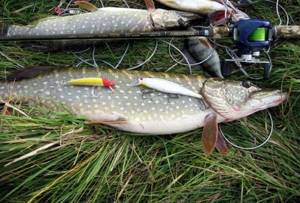
In the spring, the pike is starving; during this period it will attack any bait. A few weeks before the start of spawning, it is necessary to gain strength in order to lay eggs on time and without special costs. In March
the water has not yet warmed up sufficiently and the predator is passive, since the freeze-up period has just passed. To catch a pike at this time you will have to make an effort, because it will not rush at everything that swims in front of it. Since the water temperature is quite low, the predator stands at depth, so it is best to use jig baits and a stable, slow retrieve.
In April
You can already find a toothy one in the shallows, since the water there begins to warm up first and the fry comes out to feed, and the pike hunts for it. At this time, it is best to use small wobblers, and keep the wiring slow and without sudden movements.
In May
The pike is already beginning to fully feed in almost all areas of the reservoir. During this period, it is caught both on the surface and using baits for fishing at depth. In May, spinners go to the rivers and take wobblers with neutral and positive buoyancy from fishing boxes.
In summer
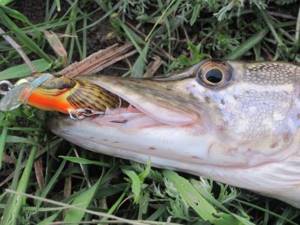
In summer, the water warms up quite well and the pike begins to actively hunt throughout the day, although if it is hot enough in your region, then it is better to go fishing in the morning or evening, since in the heat the predator takes the bait quite reluctantly. From early June to mid-July
Pike is caught very well. During this period, all fishermen recommend using baits with bright, aggressive colors.
At the end of July
The real summer heat begins, during this period the pike leaves shallow water and goes to holes or places with a current, in search of cool water. The fish loses its former aggressiveness and is more attracted to baits with a natural color, which should be carried out quite slowly.
From early to mid August
The toothy one behaves as before, still preferring places with cold water and baits with natural colors.
But in mid-August
the water temperature drops and the pike begins to be active again.
in autumn
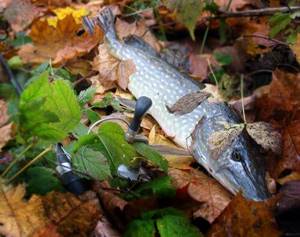
As soon as the water temperature begins to decrease, the pike needs more energy to actively move around the reservoir, which means it needs to eat more. Plus, winter is coming soon, which means you need to gain strength in order to lie down in the pits. It is in the fall that the catches of spinners become the richest.
In September
The water has not yet had time to cool completely, so it is worth trying to look for pike in places with shallow depths.
And in October,
the predator still does not leave its usual parking areas, so meeting it in shallow water is quite normal. During this period, it is better to try to attract pike with large baits. Moreover, it bites equally well on spinners and wobblers of any color.
In November
The pike is still actively feeding, but it is difficult to find it in shallow water, since it goes to the depths along with other fish. Due to such features, in the last month of autumn it is best to catch pike using a jig. You can quite successfully fish with live bait using bottom gear.
Lures for catching pike on a spinning rod in the fall - variety
Lures for catching pike with a spinning rod in the fall are varied; at this time of year, almost all types are caught. The autumn pike is so good that many spinning anglers even take special vacations to fish during this cool period.
The principle of choosing autumn spinning baits
Pike fishing in late autumn using spinning rods is conventionally divided into two periods:
- with the presence of aquatic vegetation;
- no underwater grass.
In the first of these periods, underwater vegetation does not allow conducting in any water horizon, and with the onset of night frosts and the clearing of the reservoir from vegetation, the behavior of the toothy predator also changes.
The choice of bait depending on the fishing period
It can be noted that while the grass under water has the ability to hide the predator, providing cover for an ambush, the pike takes advantage of this only on certain days, coming to the surface to chase the fry. Therefore, the best lures for catching pike with a spinning rod in the fall are:
- spinners;
- surface wobblers such as poppers or floating minnows;
- jig baits with spaced mounting.
Gradually, the aquatic vegetation dies off and sinks to the bottom, freeing up space for the pike and at the same time depriving it of its usual ambush places.
At this time, the toothy predator changes its habits and, like driven perches and pike-perch, begins a search hunt for prey throughout the entire reservoir. This is the famous autumn zhor of pike.
You may be interested in the article: “The practice of catching pike,” which will tell you more about this.
In late autumn, pike can be caught using spinning rods using almost any bait. In addition to the types already mentioned, we can name the following:
- oscillating spoons;
- spinnerbaits;
- cicadas;
- sinking wobblers and suspenders;
- jig baits on any installation.
Selection of baits by color and size
Pike in the fall distinguish the color of a spinning bait only during surface fishing, and even then the main attractive factor for the attack of a toothy predator is the animation of the retrieve.
It is important that at depth or in cloudy weather it is better to use light-colored baits, while on a clear sunny day dark-colored models are preferable. When catching an active predator, you can also use brighter colors compared to catching a passive pike.
The main sizes of bait for pike in the fall on a spinning rod range from eight to twelve centimeters. There is no point in shredding during this period, and there is no point in dragging long “logs” either.
Read more about how to catch pike in October here.
Classification of spinning baits
Now it’s time to describe all the baits mentioned above in more detail to clarify their types, shapes and technical characteristics.
Spoons
The following types of spinners are used for pike fishing:
- rotating;
- fluctuating;
- compound.
Rotating spoons are a rod equipped with a petal in the form of a tree leaf rotating at a certain angle. In addition, there is a tee at the end of the rod, and after the installed petal there is the body of the bait.
When placing such a spinner, the petal, under the influence of water resistance, begins to rotate at a certain frequency, which causes a turbulence in the water, provoking the pike to bite. The frequency and amplitude of rotation depend on the shape of the petal, its size and the winding speed of the coil.
Oscillating spoons are the oldest of spinning baits. They are an elongated metal plate curved in a special way. Vibrators can be equipped with either soldered hooks or hanging ones on winding rings.
Special cases of oscillating spinners are:
- Castmasters. Flat cuts of metal rods, mostly used in asp hunting.
- Cicadas. Flat lures with a weighted head.
- Unhooked. Spoons equipped with special antennae that protect the hooks from snagging snags or grass.
Composite lures, such as spinnerbaits, consist of a spinner bait and a bucktail, a weighted fly, mounted on a single wire frame.
Wobblers
The artificial fish, carved from pine bark by the Finn Rapala, has long conquered the fishing world. Fishing for pike with a spinning rod in the fall also uses this type of bait. The variety of wobblers is divided into two large classes:
Blade wobblers according to the shape of their body can be divided into the following types:
- crawlers;
- minnow;
- fats;
- shads;
- cranks.
Bladeless ones, in turn, can differ in the attachment point:
- with front eye: poppers, jerkbaits;
- with top eye: rattlins, darters.
Many Internet users in their reviews often praise such well-known wobblers as Jackall Tiny Magallon and Kosadaka / ZLN XS 90F, which is better known in fishing circles under the name “Green Chinese”.
Soft baits
In recently developing jig fishing, baits made of various types of silicone and foam rubber are used. They differ in form as follows:
- Twister. It has a round ringed body and a soft movable tail.
- Vibrotail. The body is flattened, like a bleak fry, and has a T-shaped tail.
- Reaper. Vibrating tail with a twister tail.
- Foam rubber. An artificial fish cut from a piece of foam rubber.
- Fantasy. Various imitations of crustaceans, mollusks or other underwater or imaginary creatures.
Soft baits are mounted in two versions:
- on a jig head;
- on an offset hook.
In the first option, the tackle is called non-spaced; fastening to the offset machine can be carried out both in direct contact with the “eared” load, and in spaced rigs, such as:
- drop shot;
- diverter leash;
- Texas;
- Carolina.
An unspaced rig involves installing a silicone on a jig head or connecting a hook to an eared weight using a winding ring. For foam rubber fish, this installation is the only acceptable one, since the lightweight foam rubber floats in the water and stands almost vertically at the bottom, simulating a fry swarming in the mud.
A drop shot is an installation in which the sinker is at the bottom, and the bait with a hook is mounted 40-50 centimeters above it directly on the main fishing line. This scheme for constructing tackle makes it possible to play in one place, which is very important in snag fishing. Read more about the drop shot.
A retractable leash, or Moscow rig, is similar to a drop shot, only the bait is attached to a piece of fishing line forty to fifty centimeters long. Used for guiding gear through bottom vegetation. More details about the outlet.
The Texas rig is also kind of spaced out. When installing it, a sliding weight in the form of a bullet or olive is put on the main line. The silicone or foam bait is attached to a hook tied to the end of the cord. More about Texas.
If we add a line insert between the hook and the sliding weight, we get what is known as a Carolina rig. More about Carolina.
Tackle for autumn spinning
Tackle for catching pike with a spinning rod in the fall should provide casting to the selected point and animation of the retrieve suitable for a specific bait. Therefore, when choosing a spinning rod, you need to consider three main rod options:
- Long with fast action. An eight to ten foot long blank will help when guiding spinners and twitching wobblers from the shore.
- Short fast rod. Fishing for pike with a spinning rod in the fall from a boat is more convenient with this form. It should be six to seven feet long.
- Jig rod. The length of the blank is selected depending on the fishing point, and in terms of action, such rods are fast, but with a slow tip, which allows you to clearly feel the bottom relief.
As for the choice of reel, it should provide winding of a thin, up to 0.14 millimeters, braided cord seventy to eighty meters long. This means that the spool of such a “meat grinder” should have a Shimano dimension of 1500-3000 units.
The spinning reel does not require any additional bells and whistles, such as a baitrunner, the main thing is that the friction mechanism is in perfect condition.
The braided cord is selected depending on the weight of the bait and can have a thickness from 0.08 to 0.14 millimeters. Using a leash when fishing for active autumn pike is mandatory if you do not want to lose an expensive bait and experience disappointment when a trophy specimen disappears.
A little about live bait fishing
Live bait fishing also gives good results for autumn pike. If in the first period of autumn, when the pike lies in ambush near the border of the grass with clean water, it is easiest to reach it with a float bait, then in the second half of the autumn season you need to do things a little differently.
In reservoirs with shallow depths, up to three meters, the use of a float rod is justified even now, but in places with great depths, a live bait bottom is often used, or a feeder rod is re-equipped. With such tools you can get pike from any depth.
The following are used as live bait for catching autumn pike:
- crucian carp;
- roach;
- rotana;
- loach;
- bleak;
- rudd;
- perch
Fishing technique
The technique of such fishing is quite simple, but at the same time quite complex. Most stages of fishing involve simply casting gear and hauling it ashore. But it is necessary to drag the tackle in accordance with a certain technique, which we will discuss below.
Let's look at the sequence of correct actions if you still manage to provoke a predator to attack. After all, the pike will need to be hooked correctly, and then the catch will need to be pulled out. This is exactly what beginners often have problems with, for whom fishing for pike with a spinning rod loses its relevance after several unsuccessful fishing trips.
How to hook correctly?
It is necessary to hook a pike immediately after a bite, and every time you notice a bite or something similar to it. The shortest possible hooking is possible with a rigid spinning rod with a fast blank action. If you use a spinning rod with a slow action, the hook will be more sweeping.
After you have hooked and felt the heaviness at the other end of the line, it is better to hook the pike again
. The main thing is not to let the pike feel weak and try to tire it out as much and quickly as possible.
The predator has a very powerful mouth, so you should not behave carefully when hooking, as it is very difficult to tear its mouth. A pike can fall off the hook for only one reason - it is poorly hooked.

How to fish?
What is worth noting first of all is that to successfully catch a predator, you need a powerful leash. In the absence of a leash, the likelihood of losing fish and bait increases significantly, and catching pike with a spinning rod will bring you nothing but disappointment. The reason for this is quite simple - sharp teeth can easily cut the bait from the fishing line or cord.
After you hook a fish, you will be overwhelmed with emotions, but here you need to act very calmly and clearly, and most importantly, all actions must be as clear as possible. Try to feel every movement of the fish underwater.
- Under no circumstances allow the pike to sink to the bottom. As soon as you feel that the fish is trying to change its position in the water, try to tighten the line to avoid this.
- Now you need to very carefully, slowly and carefully lift the spinning rod.
- When the tip of the spinning rod takes a horizontal position, you need to sharply lower it down and quickly wind the weakened fishing line onto the reel.
- Now you need to repeat steps 2 and 3 until the predator is very close to you.
Even if there is a fairly large pike at the other end of the line and you feel strong resistance, after a while it will get tired and it will be much easier to pull it ashore. The best way to do this is to use a landing net.
I hope that everyone liked the article and now fishing for pike with a spinning rod will bring a rich catch and a lot of pleasure for every angler. Don't forget to share the article on social networks, write comments, and watch the video.
Wobblers
Choosing bait for pike
Wobblers have gained significant popularity in recent years and have become worthy competitors to spinners, this is primarily due to the wide range and variety of modern models presented on the fishing market.
However, this factor often complicates the process of choosing the most suitable bait option, so below are features that can help fishermen in this process:
- The length of a wobbler for pike can be from 5 to 20 cm, this parameter depends on the size of the potential prey. The largest models are used for fishing for trophy specimens.
- The depth level is a characteristic of a wobbler, which directly depends on the angle of inclination of the blades: elements located perpendicular to the main surface of the bait indicate that it is of the surface type. The maximum value for river models is usually 10-15 meters; selection in accordance with this parameter is necessary based on the depth of a particular reservoir and the places where the pike is located at the time of fishing.
- According to the level of buoyancy, all models of wobblers can be classified as floating , sinking and universal, which can remain in the water column for a long time. The choice of bait in accordance with this criterion depends on the current location of the prey and the characteristics of the fishing conditions.
- Features of the wobbler game, which can be passive or, conversely, distinguished by its activity. For catching pike, the first option is usually used, especially in the summer, when this predator prefers to grab slow fish and not chase prey that is too fast.
- The color of the wobbler is chosen based on the same considerations as when fishing with a spoon, that is, it depends on the weather and light level. You can also focus on the diet of pike in a particular body of water, choosing models that look as similar as possible to its usual prey.
The best wobblers
In order to make it easier to choose wobblers for pike fishing, below are examples of models that have proven themselves to be the best:
Yo-Zuri L-Minnow F200 (66) is a sinking type wobbler; its use is justified in situations where a predator needs to be lured out from a considerable depth. The action of this bait is distinguished by its activity, and the design features easily allow you to make long casts and add stability when making a retrieve. The approximate cost is 350-400 rubles.
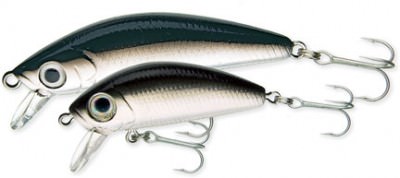
Salmo Slider is a wobbler from a leading manufacturer of lures of this type; it consistently shows good results and is very often used during periods when pike are passive, since it is guaranteed to attract the attention of a predator. The approximate price is 600 rubles.
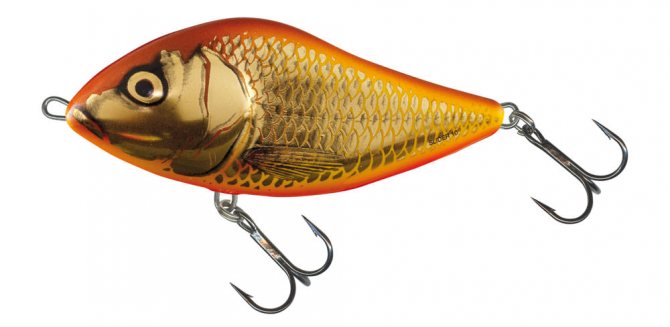
The Zip Baits Rigge 90F is the largest option in its range and is ideal for pike fishing. It belongs to the sinking type of bait, therefore it is effective when it is necessary to lure a predator from the bottom and retains all the main advantages of its type. The price for such a wobbler is about 1000 rubles.
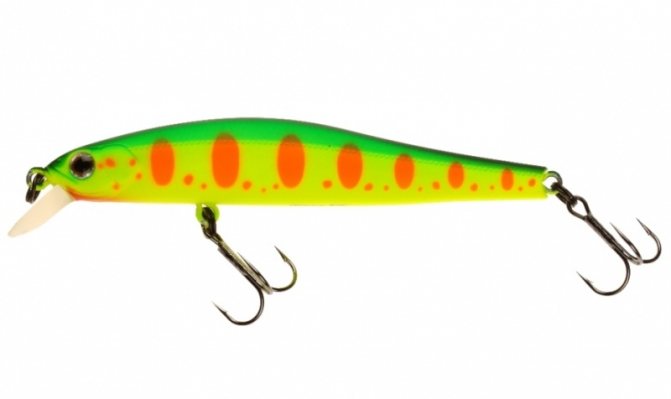
Useful tips
To always have a catch, you need to listen to the advice of more experienced fishermen. Many share their experience with young people, but personal observations in this matter will not hurt. Pike fishing will be more successful if you use the following tricks:
- At any time of the year, the bait must be attached to the main one through a leash; when hooked, this will help preserve the main tackle, and when biting, it will not allow the pike to immediately cut off the bait.
- When choosing baits, do not forget to pay attention to their weight and compare this indicator with the test on your spinning rod.
- It is better to give preference to baits from well-known companies; they will definitely work better than cheap analogues.
- In sunny weather, the bait should be darker; spinners and spinners are chosen in copper color, but in cloudy weather they offer silver and gold to the pike.
- When choosing pinwheels, pay attention to the shape of the petal; a round one is more suitable for lakes, ponds and bays with minimal current. The extended version is used for fishing rivers.
- Light-accumulating silicone is suitable for fishing at night and in the evening, and during the day it is better to give preference to acid fish and fish of natural colors.
- As a leash for pike, it is better to use soft but strong steel or thicker fluorocarbon.
- It is not recommended to use leashes that are too short; they will not allow the bait to play properly.
For the rest, the spinner relies on his skills and knowledge; a previously studied bottom and terrain features will help in catching the toothy predator.
Lures for spinning pike fishing are chosen according to different criteria, but personal preferences should also be taken into account. After all, every fisherman can say that he feels his own lucky bait.
You can ask your question to our author:
Jig baits
An alternative option is to use jig baits, which in most cases are universal and suitable for different breeds of predators.
However, pike baits of this type still have a number of individual characteristics, which are discussed below:
- The speed of penetration is one of the determining criteria ; it is necessary to choose options that sink to the bottom surface slowly enough, periodically pausing for 10 seconds.
- The jig bait used must correspond not only to the breed of predator that you plan to fish for, but also to the test parameters of the rod itself. This is necessary in order to promptly notice even the most insignificant and unnoticeable bites.
- The weight of the sinker usually depends only on the direction and speed of the current: the stronger it is, or when fishing against the current, you need to use heavier options.
- Size and shape also play an important role: a jig bait for pike should be large enough for a predator to notice it, as well as voluminous and have an elongated shape.
- The color is chosen depending on the fishing conditions , it is influenced by the usual diet of the predator in a particular body of water, the topography and structure of the bottom surface, the level of lighting and the transparency of the water itself.
- Among the assortment of such baits you can find full-fledged painted baits or separate heads with eyes ; both options are suitable for pike fishing; this design feature does not affect efficiency.
Jig equipment
To catch pike with a jig, in most cases a regular jig head with a silicone bait or a swivel joint on a collapsible Cheburashka (or a head with a fastener) is used. On an articulated head, the bait is attached to an offset or double hook. The double or offset press is attached through a collapsible sleeve or fastener to the sinker. After preparing the bait, we attach it to the carabiner of a regular leash or directly to the twist of the equipment - it makes no difference, both methods are suitable.
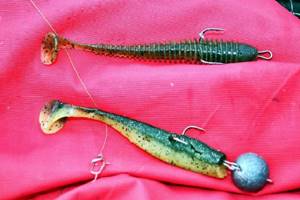
Exploded snap-ins
Drop-shot, split-shot, Texas and Carolina are more often used for perch and walleye. However, such equipment is also used for passive pike. Sometimes a toothy fish may not take a regular jig, reacting only to playing on the spot with a drop shot or to the slow fall of the bait. Naturally, mounting a spinning rod on a pike for a spaced jig must also be done with metal leashes in the equipment. The same weights of bullets, sticks, eared ears are used, only instead of fishing line or fluor for bait - twisted steel or a soft metal leash. Carolina or Texas are mounted directly on the leader material.
Read more about installing jig rigs
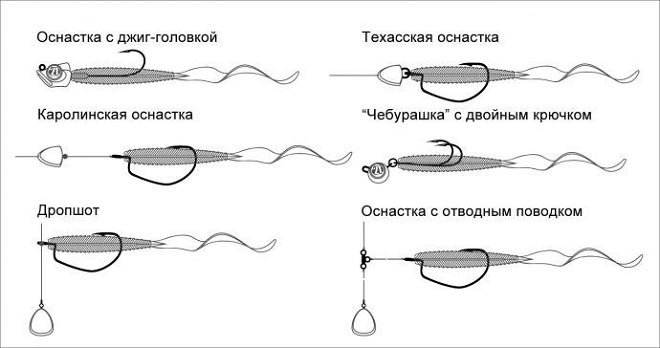
Bombard
Assembling a spinning rod for pike with a bombard can be useful in some narrow cases. For example, when a fisherman has a rough, heavy spinning rod, and needs to cast with light spinners or streamers. The equipment for catching pike with a bombard is the same as in other cases - at the end of the cord there is a swivel, in front of which a sbirulino float moves freely. Next is a piece of fluorocarbon or a metal leash.
Such equipment, for example, can be used for catching pike with a spinning rod using live bait. At the same time, it is better not to throw live bait so that it does not get damaged, but to lower it to a point downstream. When installing the tackle for pike with sbirulino, you can put a piece of fishing line of the required length between the swivel on the cord and the leash to increase the working descent. However, the longer the hang after the bombard, the harder it is to work with the equipment.
Bombarda for pike is usually bright, acidic orange or yellow in color, to attract the predator from afar, luring it out of the thickets. The pike comes out to a noticeable spot from a distance, and attacks a spinner, a small wobbler or a streamer going deeper.
